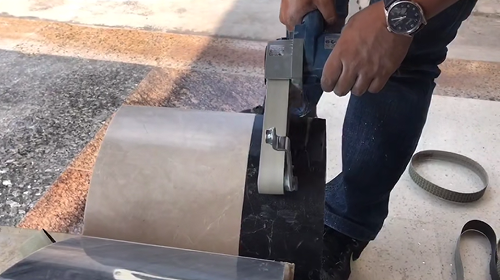Diamond abrasive belts and diamond flap discs both belong to the classification of abrasive tools, abrasive belt is more flexible than other abrasive tools and more adaptable to the working environment. Although the abrasive belt and the flap discs are both abrasive tools, they have their own advantages. Today we will introduce the advantages of the abrasive belt from the flap discs.
1. One of the main advantages of belt grinding is its ability to adapt to different surface types. Whether flat, internal, external, or complex curved surfaces, belt grinding can easily and effectively grind and shape materials. As a functional component, abrasive belts can be installed on a lathe for post-turn grinding, or they can be installed on a planer or other special grinding machines. This versatility allows manufacturers and mechanics to adapt to different requirements and easily achieve the desired results. By utilizing this feature of belt grinding, previously challenging machining processes can now be completed quickly and efficiently. For example, precision machining of extremely long and oversized shafts often presents difficulties due to the size and complexity of the workpiece. However, by using belt grinding, these hurdles can be overcome without much effort, resulting in faster turnaround times, higher precision, and overall increased productivity.
2. Abrasive belts are available in a variety of base materials, abrasives, binders, grain sizes, lengths, widths, and forms, and manufacturers can customize their selections to suit their specific needs and purposes. This versatility ensures that the abrasive belt can be customized for different grinding applications to provide the best possible results. Whether choosing a stable substrate, an abrasive material that grinds efficiently, or an adhesive that bonds firmly, manufacturers have the flexibility to choose the perfect combination. Additionally, the specifications for grain size, length, and width can be adjusted to achieve the desired surface finish and material removal rate. The availability of various forms such as rollers and rings further adds to the convenience and adaptability of abrasive belts for different types of machinery and applications.
3. Abrasive belt grinding can process the same workpiece with multiple grinding methods and process structures. The following are some commonly used grinding methods and process structures:
Surface grinding: The abrasive belt is fixed on a flat workbench or an abrasive belt grinder, and the workpiece passes through the abrasive belt for grinding. This method is used to remove unevenness on the surface of the workpiece or to adjust the size of the workpiece.
Edging: Wrap the abrasive belt around the grinding wheel and perform edging by turning the grinding wheel. This method is suitable for process requirements such as trimming and deburring.
Contour grinding: The abrasive belt is fixed on a special-shaped pulley, and the grinding of the workpiece contour is realized by adjusting the angle and position of the pulley. This method is suitable for profile grinding and profile dressing.
Internal grinding: A specially designed abrasive belt grinder is equipped with a flexible abrasive belt, which is sent into the inner hole of the workpiece by a special clamping method for grinding. This method is suitable for internal grinding and processes requiring a high surface finish.
In addition, the process structure is also an important factor affecting the results of abrasive belt grinding. Common process structures include single-belt, double-belt, and sealed track systems. Different process structures are suitable for different process requirements. For example, the single-belt structure is suitable for workpieces with high surface flatness requirements, the double-belt structure can improve production efficiency, and the sealed track system can reduce the impact of environmental dust on the workpiece.
4. Belt grinding is known for its versatility and ability to machine a wide variety of engineered materials. It can effectively grind ferrous and non-ferrous metals, including copper and aluminum. In addition, it is also suitable for processing non-metallic soft materials such as wood, leather, and plastic. One of the unique advantages of belt grinding is its “cold” grinding effect. Unlike conventional grinding methods, which generate excessive heat during processing, belt grinding generates less heat. This is especially useful when working with heat-resistant and difficult-to-grind materials. The reduced heat minimizes the risk of material damage such as thermal deformation or changes in hardness that can occur with other grinding techniques.
Post time: Jul-12-2023


